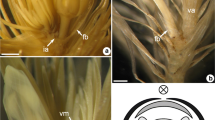Abstract
Floral morphology ofBrasenia schreberi Gmel. andCabomba caroliniana A. Gray was observed chiefly from an anatomical point of view. The receptacle ofB. schreberi is rather flat and a vascular plexus is observable in the mature flower. The vasculature in this plexus is so complex taht it is not easy to trace its structure in detail. by observation on small buds, it can be seen that the receptacular vasculature consists of a girdling bundle in the basal area and usually nine receptacular strands from which traces to the petals and stamens branch off. The vasculature in the receptacle is reconstructed and diagramatically shown as though split longitudinally and spread out in one plane.
Floral vasculature inCabomba caroliniana is simpler, and is probably related to the smaller number of stamens and carpels. It also has a girdling bundle at the bottom of receptacle and this vasculature is suggested to be derived by simplification from aBrasenia-type vasculature.
Evidence from floral anatomy suggests that these two genera are closely related. InNymphaea, a vascular plexus in the receptacle is also observed (Moseley, 1961; Ito 1983). The plexus ofBrasenia andNymphaea are not the same in their construction. Nevertheless, their fundamental floral vasculature is comparable and it is preferable to place them in the same family or same order.
Similar content being viewed by others
References
Burger, W.C. 1977. The Piperales and the Monocots. Alternate hypotheses for the origin of monocotyledonous flowers. Bot. Rev.43: 345–393.
Caspary, R. 1891. Nymphaeaceae.In: A. Engler and K. Prantl, ed., Die natürlichen Pflanzenfamilien Part III, ser 2. Wilhelm Engelmann, Leipzig.
Collinson, M.E. 1980. Recent and tertiary seeds of the Nymphaeaceae sensu lato with a revison ofBrasenia ovula (Brong.) Reid and Chandler. Ann. Bot.46: 603–632.
Conard, H.S. 1905. The Waterlilies. Carnegie Inst., Washington.
Cronquist, A. 1981. An Integrated System of Classification of Flowering Plants. Columbia Univ. Press, New York.
Eames, A.J. 1961. Morphology of the Angiosperms. McGraw-Hill, New York.
Eckardt, T. 1937. Untersuehngen über Morphologie, Entwichlungsgeschichte und systematische Bedeutung der pseudomonomeren Gynoeciums. Nova Acta Leopold. N.F.5: 1–112.
Gray, A. 1837. Cabombaceae. Ann. Lyc. Nat. Hist. N.Y.4: 46.
Goldeniewska-Furmanowa, M. 1970. Comparative leaf anatomy and alkaloid content in the Nymphaeaceae. Monogr. Bot.31: 1–55.
Ito, M. 1982. On the embryos and seedlings of the Nymphaeaceae. Acta Phytotax. Geobot.33: 143–148 (in Japanese).
— 1983. Studies in the floral morphology and anatomy of Nymphaeales. I. The morphology of vascular bundles in the flower ofNymphaea tetragona George. Acta Phytotax. Geobot.34: 18–26.
— 1984. Studies in the floral morphology and anatomy of Nymphaeales. II. Floral anatomy ofNymphaea tetragona George. Acta Phytotax. Geobot.35: 94–102.
Li, H. 1955. Classification and phylogeny of Nymphaeaceae and allied families. Amer. Mid. Nat.54: 33–41.
Moseley, M.F. 1961. Morphological studies of Nymphaeaceae. II. The flower ofNymphaea. Bot. Gaz.122: 233–259.
— 1965. Morphological studies of Nymphaeaceae. III. The floral anatomy ofNuphar. Phytomorphology15: 54–84.
— 1968. Morphological studies of Nymphaeaceae. VI. Development of flower ofNuphar. Phytomorphology21: 253–283.
—. 1984. Morphological studies of Nymphaeaceae. XIII. Contributions to the vegetative and floral structure ofCabomba. Amer. J. Bot.71: 902–924.
Richardson, F.C. 1968. Morphological studies of Nymphaeaceae. IV. Structure and development of the flower ofBrasenia schreberi Gmel. Univ. Calif. Pub. Bot.47: 1–101.
Schneider, E.L. 1976. Morphological studies of the Nymphaeaceae. VIII. The floral anatomy ofVictoria Schomb. (Nymphaeaceae). Bot. J. Linn. Soc. London72: 115–148.
Solereder, H. 1908. Systematic Anatomy of the Dicotyledons Vol. 1, English ed. Clerendon Press, Oxyford.
Takhtajan, A. 1969. Flowering Plants. English ed. Oliver and Boyd Ltd., Edinburgh.
— 1980. Outline of the classification of flowering plants (Magnoliophyta). Bot. Rev.46: 225–359.
Tamura, M. 1982. Relationship ofBarclaya and classification of Nymphaeales. Acta Phytotax. Geobot.33: 336–345 (in Japanese).
Ueno J. andS. Kitaguchi 1961. On the fine structure of the pollen walls of Angiospermae. I. Nymphaeaceae. J. Biol. Osaka City Univ.12: 83–90.
Author information
Authors and Affiliations
Rights and permissions
About this article
Cite this article
Ito, M. Studies in the floral morphology and anatomy of nymphaeales. Bot Mag Tokyo 99, 169–184 (1986). https://doi.org/10.1007/BF02488818
Received:
Issue Date:
DOI: https://doi.org/10.1007/BF02488818




